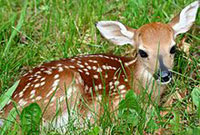
Why food plots? Primarily - to provide additional or supplemental food resources for wildlife when natural food sources are limiting or in low quality. Secondarily - to increase incidental sightings of wildlife and to help hold them on a property. With that said, food plots are not a replacement for lacking native vegetation. A diverse native plant community is what you really want, but many of our habitats arenít there yet so food plots can help to fill in the gap.
When to plant food plots? Ė spring and fall. This article will focus on fall food plots. Fall food plots are typically put in September through October. The soil temperature is still warm enough to germinate seeds, extreme temperatures begin to wane, and of course the rains return.
What do I plant in my fall food plots? First, fertilizer. Fertilizing makes the difference. You must have adequate soil fertility to produce a thriving beneficial food plot. Soil test in advance to see what nutrients are needed to grow the crop you are wanting to plant. A soil test cost $10 plus a little effort. It will let you know the soilís pH, the nutrient availability, and tell you the type and quantity of fertilize you need to put out. Soil test forms are available at your local Extension office.
Cool season forage choices are winter hardy oats, wheat, rye, turnips and mustards, iron clay peas, clovers, and winter peas. A great combination is oats, wheat, clover, and iron clay peas. The iron clay peas will freeze out but will be much enjoyed by the deer before the freeze event. The peas provide high quality food when other warm season native plants are going dormant and are lacking in crude protein levels. North Texas usually has it first frost in mid-November. When choosing a clover consult with your Extension agent because the choices are dependent upon soil pH and texture.
Where do I plant food plots? Plant food plots where you can get five to six hours of direct sun. Any less sunlight and your food plots will struggle. Plant food plots in nonerodible areas where slopes are zero to slight. Fall food plots should be planted close to cover. During the winter, trees and shrubs drop their leaves and cover and concealment become lacking. Deer will hang tight to the remaining cover to minimize exposure to hunters, predators, and extreme weather so it makes since to plant close to cover. Fall food plots should also be smaller in size than summer plots and more of them. Get away from planting food plots in straight lines and rectangles. Make them twist and turn and be irregular in shape.
Another good location for food plots is in areas where you want a firebreak. A firebreak is a gap in vegetation or other combustible materials that act as a barrier to slow or stop the progress of a wildfire/brushfire. When food plots are lush and green these strips wonít burn and are a natural firebreak. When your food plot isnít in use, then keep it tilled/disked maintaining it as a firebreak. Food plots should compose no more than three to five percent of your total habitat.
How to plant a food plot? Everyone has different kinds of equipment or planting implements available for their use. Some just have a disk and a piece of cyclone fence for a drag and others have a seed planter, chain harrow, and cultipacker. So Iíll just cover the basics.
First, remove all the existing vegetation by spraying, mechanical removal, or both. Incorporate in the fertilizer (turn it into the soil) while breaking up the soil.
Second, smooth out the soil and then firm it up. Soil can be firmed up with a cultipacker, roller, or by rainfall.
Third, plant seeds. Might have to make two passes because bigger seeds like iron clay peas need to be planted deeper than the small clover, rye, oats or wheat seeds. Once you dragged in or covered the bigger seeds, come back and broadcast/plant the little seeds on top. Press the smaller seeds into the soil surface or lightly cover.
Lastly, pray for rain.
Another good thing to do is to build some kind of wire enclosure around a small section of your planted area. The enclosure could be a small three foot diameter circle four foot high that would keep deer, rabbits, cows, goats, and turkeys from getting to the food source. This is how you can monitor the grazing intensity on your food plots.
Ok, there is a little bit of information on fall food plots. Go out and have fun while at the same time knowing you are helping our native wildlife. If you need any assistance, call my office at 903-813-4202.